
-----
Problem etching stainless steel with ferric chloride - Pitted Finish
Q. I have been trying to etch a pattern on a sheet of stainless steel. The resist is ink (I printed the pattern on blue pnp paper and ironed the ink pattern onto the steel).
I put the piece in a cup of ferric chloride
⇦ on
eBay or
Amazon [affil link] which is 42 baume. I found that after about an hour and a half the more delicate details of the ink started to come off, but the steel itself was barely being etched. I ended up re applying the ink resist several times and leaving it in for hours at a time (12+ hours). Despite this the amount of etching done was minimal and you could just about feel it if you ran your finger over it (barely).
I know this is not how it's supposed to work (I read online it would take just a few minutes). I was wondering if anyone had any advice on how I could get a relatively detailed pattern onto steel relatively quickly and achieve some depth (less than 1mm even).
Thank you for any help you can offer me.
- Ennis, Clare, Ireland
January 20, 2022
A. Hi Martin,
Do you know what grade of stainless steel you have? "Stainless" covers a wide range of materials with different etch behaviours. What works for 304 may not for 316.
What temperature are you running at?
I recommend you get some scrap pieces without any resist and play with concentration and temperature until you find something that gives you a good even etch on this material.
Then try again with the resist.
- Melbourne, Australia
February 16, 2022
⇩ Related postings, oldest first ⇩
2004
Q. Hello, we are a sign manufacturer. On a regular basis we use 45 baumé ferric chloride ⇦ on eBay or Amazon [affil link] to etch 304 stainless .007 to .015 inches deep. This is done at 47 °C. Sometimes however I get a very bumpy etch in wide areas. It almost looks like part of the stainless composition is breaking down faster than others but that is my guess.
I've documented this problem with photos and detailed information. These are all examples of 304 stainless steel panels etched with 45 Baumé ferric chloride ⇦ on eBay or Amazon [affil link] (FeCl3) in a spray nozzle conveyor system. The ferric chloride ⇦ on eBay or Amazon [affil link] is heated to 45° C and has less than 3% hydrochloric acid as content when it is received.
Example of Smooth Etching (Acceptable)
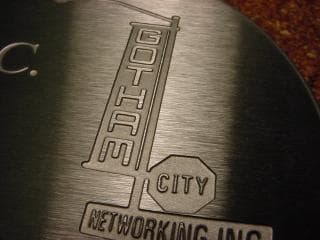
Example of Reverse Etched Problem - small pits (Unacceptable)
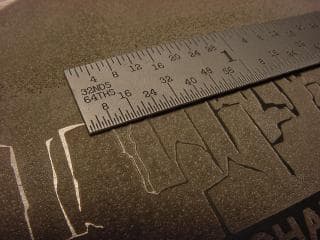
Example of Reverse Etched Stainless -- Small raised areas within smooth etched area (Unacceptable)
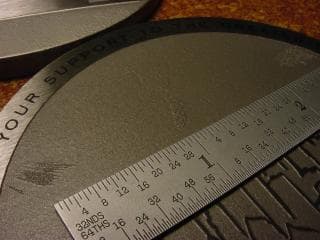
Example of Reverse Etched Area that is smooth near the shoulders but bumpy in the wide open areas (Unacceptable)
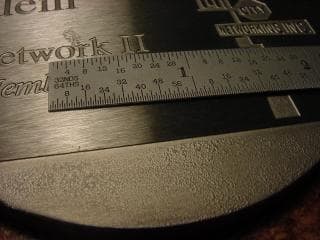
Extreme Example of Shot Blast Look in Etched Area. I believe this was done with 30 baumé ferric chloride ⇦ on eBay or Amazon [affil link] .
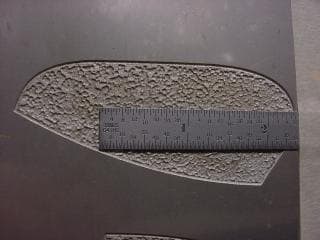
I appreciate any assistance that can be given! Unfortunately we are not chemists and only have a few basic measuring instruments -- i.e. Hydrometer and Thermometer. Thank you.
Jon LorberArchitectural Signage Shop - Amityville, New York, United States
Q. I was trying to get etching on stainless steel plate by Ferric nitrate solution plus small amount of nitric acid. It is not working. I don't know the reason. It works when I use ferric chloride
⇦ on
eBay or
Amazon [affil link] plus nitric acid. I wanted chloride ion free stainless steel plate, so I am using ferric nitrate. can you give some solutions.
Thanks
Yonsei University - Seoul, Korea
2005
Q. How Many Tablespoons of Ferric Nitrate in a Quart Of Water? Hello, I'm Doug Mosley; an artist from Portland, Oregon.
I use antique steel and iron farm tools and machine parts to create abstract sculptures. I have been using ferric nitrate in a very undisciplined fashion. I would like to know how much chemical to add to a quart of water to achieve a standardized concentration. I realize the found steel and iron objects I use in my work are inconsistently alloyed - this is why I need to standardize my ferric nitrate solution. Also, I have found that misting a treated surface with water will speed up the appearance of bright orange rust. Is it safe to seal this without further rinsing? I am trying to achieve a lighter color finish when sealed. I have been getting a brown or black color only.
Metal Sculptor - Portland, Or, USA
April 23, 2008
Q. Can anyone recommend a good resist stencil film that will adhere well to 304 Stainless for etching in ferric chloride
⇦ on
eBay or
Amazon [affil link] . I have tried Oramask 813 but it just lifts right off.
Thanks.
- Carbondale, Illinois, USA
January 18, 2013
Ed. note: We don't post brand and sourcing recommendations (why?), but you're welcome to post an RFQ for private contact about this if you wish. Still, it's more likely that the problem revolves around the best techniques for adhering stencil films and/or the best material for stencil films when etching with ferric chloride ⇦ on eBay or Amazon [affil link] , rather than that some manufacturers' stencils being vastly better than others.
A. We use liquid photo resist and this does not come out even when we go 1 mm deep.
It's ready to use, just spray and bake it at 80 degree for 20 minutes.
Hope this helps.
- Delhi, India
June 8, 2013
Q. Hi,
Gupta Gi, which type of liquid resist do you use?
- sharjah uae
February 14, 2014
Ed. note: Readers, please don't ask for brand or source recommendations (why?). It's very unlikely that different brands of the same polymer are vastly different anyway.
Q. Jon, I use etching machine with spray nozzles and conveyor also and am presently having a similar issue after putting in fresh acid. Please let me know if you find an answer.
kevin payseur- cramerton North Carolina
May 6, 2015
A. Hi. Your problem is a very common problem. After laminating the film to the plate and exposing it you need to bake it in a 120 °C oven for 20 to 30 minutes. The film will change color to very dark violet and it will be very strong and resist the acid, not only for engraving but also for cutting.
The issue with uneven engraving: I am sure it comes from the kind of machine you are using. You need to use a double spray etching machine with conveyer. This is the only way to have the acid well distributed on the plate.
Thanks.
- Fair Lawn, New Jersey, USA
April 9, 2016
A. I think the problem is in the heterogeneity of steel. Poor quality steel. Try to change the manufacturer and supplier of steel.
Georgi GenovEtching machine manufacturer - Sofia, Bulgaria
July 12, 2016
Etching a full size pattern
Q. My situation:I have an enquiry for an etched plate. We manufacture rubber sheets that are vulcanised against a steel plate with the pattern on. The current plates are 30+ yrs old and are now in poor condition. They are 4 mm thick mild steel plates, we are considering stainless at 3 mm. We are told that acid etching is the best method.
The overall size of the plate needs to be 1300 x 1050 mm
The pattern depth is 0.35 mm deep.
I have spoken to a couple of companies, but one can do the size but not the depth, the other can do the depth but not the width.
Both are critical .
How are both achieved, and can anybody help with this problem?
Employee - Liskeard , Cornwall, UK
July 13, 2018
Ed. note: This RFQ is outdated, but technical replies are welcome, and readers are encouraged to post their own RFQs. But no public commercial suggestions please ( huh? why?).
A. Stainless steel pitting:
When etching Stainless with ferric chloride
⇦ on
eBay or
Amazon [affil link] , it is best etched in one pass. If you etch stainless and then rinse with water and etch again the surface will pit and get worse with each rinse. If it must be rinsed then it must be completely dry before continuing the etch. Also surface preparation is extremely important prior to resist application.
- Phoenix, Arizona.
January 11, 2019
A. Have you considered anodic leveling as a solution to surface roughness?
Anodic leveling attacks the high spots first and would seem to offer a solution to uneven etching.
It represents a 2nd operation but is only needed when results are poor.
- Paisley, Renfrewshire, Scotland
March 5, 2019
Q, A, or Comment on THIS thread -or- Start a NEW Thread